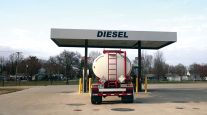Diesel Fuel Up for Third Week To Highest Level Since Nov. ’08
This story appears in the March 15 print edition of Transport Topics.
The average price for retail diesel rose for a third straight week, this time by 4.3 cents to $2.904 a gallon, to the highest level since November 2008, the Department of Energy reported.
Diesel is now 85.9 cents a gallon higher than it was at the corresponding period of 2009, DOE said after its March 8 survey of fueling stations.
The agency reported that the retail gasoline average also rose for a third week, climbing 4.9 cents to $2.751 a gallon. The gas average is 81 cents higher than it was a year ago.
The last time prices for refined petroleum were this high was Nov. 10, 2008, for diesel, when it stood at $2.944. The gasoline average tied the level of Jan. 11, and those prices are the highest readings since Oct. 20, 2008, when it was $2.914.
A truckload executive in Texas said he can overcome smaller increases with fuel surcharges and other management techniques, but at some point, volatility can become shattering.
“We don’t plan for what happens if it’s $2.50 a gallon or $3 in six or 12 months. The problem is when increases become dramatic,” said Bee Trucking President Rick Staller. “If it goes up 10 cents to 15 cents in a week, our contracts are pegged to the Monday DOE number, so what we buy on a Thursday then, we can’t begin to recover until the next week.”
All of San Antonio-based Bee’s contract customers — mainly retailers — pay fuel surcharges, Staller said, but hunting for backhauls or bridge loads to minimize empty miles puts his trucks at the mercy of the spot market, which usually doesn’t offer surcharges.
Meanwhile, the new owner of an established fleet said fuel prices drove many of his early actions.
“We’ve invested in some auxiliary power units, increased driver training to make them more aware of mileage and changed our spec’ing on trucks for better mileage. We’re also in discussions and negotiations with vendors on what steps we can take on buying fuel,” said Clay Halla, who has been CEO of McGriff Transportation since March 1.
Halla said he and his partner, Conner Burns, have managed McGriff, Cullman, Ala., since Jan. 1 and started making changes during the due-diligence phase of their acquisition. Halla said they also bought fuel-optimization software, and the company’s newly installed business plan assumes oil moving to $100 a barrel and diesel fuel topping $3 a gallon.
“We’ve done a lot of what we can do in order to mitigate those increases. It allows you to be successful,” he said.
Looking to the future, DOE’s Energy Information Administration said in its monthly Short-Term Energy Outlook, which was issued March 9, that retail diesel would average $2.96 a gallon this year and rise to $3.14 in 2011 as the economy gathers strength. The average last year was $2.46.
“As with motor gasoline, the forecast recovery in the consumption of diesel fuel in the United States — as well as growth in distillate fuel usage outside the United States — slowly strengthens refining margins for distillate throughout the forecast period,” EIA predicted in its report.
While the report said U.S. demand for diesel should in-crease this year, it will do so from a low level because diesel usage declined in 2009.
“Distillate fuel consumption declined by 310,000 barrels per day, or 8%, in 2009, led by a sharp economy-related decline in transportation usage,” EIA said. In contrast, gasoline consumption was flat from 2008 to 2009.
Oil prices on the New York Mercantile Exchange hovered at a high level between $81.49 a barrel on March 9 and $82.11 on March 11.
The EIA Outlook calls for crude to average $80 a barrel this spring, $82 toward the end of this year and $85 in 2011.
In terms of current supplies, U.S. crude oil stocks increased from Feb. 26 to March 5, whereas ultra-low-sulfur distillate and gasoline tightened, according to DOE. There was also less refinery utilization.
Crude stocks widened to 343 million barrels from 341.6 million. The ultra-low-sulfur distillate inventory contracted to 91.7 million barrels from 93.3 million, and gasoline stocks dipped to 229 million barrels from 231.9 million.
Refinery utilization moved to 80.7% from 81.9%.




